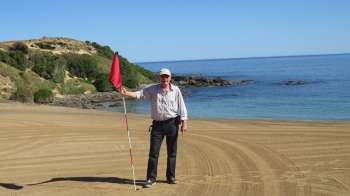China GOLF Magazine - Lessons from Royal Melbourne and the 2011 Presidents Cup
China GOLF Magazine – Darius Oliver column
As readers will be aware, in November the Presidents Cup was held at the Royal Melbourne Golf Club in Australia, one of the world’s finest championship courses. Royal Melbourne is a special place to me, because I caddied on the West Course as a young kid and was able to play in the afternoons when the courses were free. In the summer I would sometimes play 36 or more holes from late afternoon until sunset. Playing such strategic, fun and interesting holes proved the ideal way for me to really learn the game of golf properly.
The reason I am so passionate about great golf design, is because I believe that the virtues taught us by the great old courses are so worthwhile, and so easy to replicate. I’m not the only one who looks at Royal Melbourne and marvels; some of the American players at the Presidents Cup declared it the ‘best course they have ever played.’
Tiger Woods called it ‘incredible’, Phil Mickelson ‘awesome’, while Presidents Cup rookies Webb Simpson and Hunter Mahan were also gushing in their praise. Simpson said it was fun to play because, ‘you’ve got to use your head on every shot’ while Mahan stated that Royal Melbourne was, ‘a great course, it’s really aesthetically pleasing and the bunkering is amazing. Really it’s going to be a fun, fun golf course.”
Let’s just remember a few key facts about the course these guys were all talking about. The Royal Melbourne Composite Course used for the Presidents Cup measured just 6,300 metres, and had no water hazards and no out of bounds areas. The fairways were massively wide, and the greens large and open at the front. You could easily play the course all day without finding any of the bunkers, but in avoiding the most strategically placed hazards you invariably leave yourself on the wrong side of the fairway, from where pars or birdies become impossible. It really is the simplest and most beautifully strategic great course in the world.
Two of the crucial ingredients that make Royal Melbourne such a fantastic test of golf are width from the tee, and firm greens. In China, wide golf course are often frowned upon as too easy, but consider the best golf courses in the world – Royal Melbourne, Augusta National, St Andrews etc – and each is very wide and forgiving from the tee. Of course wide fairways in China would not work unless the designers creating the golf courses truly understood strategic design, and the principals that make all these layouts so brilliant. Wide fairways are only appropriate when the green complexes are arranged to favour one side or another.
Likewise, firm and fast playing conditions are difficult in China too because superintendents are often focused on green and lush turf over a springy, healthy plant. The truth, however, is that if China wants to produce world-class golfers, it needs to develop world-class golf courses and provide proper golf conditions for its participants to play. You might have noticed at Royal Melbourne that golfers never really had to clean their balls, and that when approach shots landed on the green the first bounce was forward and hard, rather than soft and backwards.
Hitting shots from tight fairways onto firm greens presents a far more thorough examination of your skills because not only do you need to catch the ball precisely with your iron, you have to judge how it will react when it reaches the target. Obviously in humid parts of southern China it’s difficult to grow fine blade fairway grasses and keep the greens firm, but further north and along coastal areas there is no excuse for at least trying to present firm and fast conditions.
Royal Melbourne is one of the giants of the golfing world, and a course that all Chinese developers and club managers should look at for inspiration. You don’t need long, lush and narrow courses to challenge the best players in the world. Royal Melbourne is actually quite an easy place for average golfers because there is so much space to avoid hazards and make simple bogeys. The genius of the course is that it gets more difficult when you start trying to make pars and birdies. That’s a virtue I would hope the Chinese golf industry tries to emulate, because we need to build more strategic, more fun, more challenging and more interesting golf courses here. So rather than looking at the TPC model for inspiration, developers, project managers and architects should cast their eyes south and learn from the Australian industry instead.
International team Captain, and local Aussie, Greg Norman summed it up best when he described Royal Melbourne as ‘heaven’ and added that he was, ‘disappointed he’s not playing because the greens are so beautiful, the course looks so beautiful. I just want to get out there and play.’ That’s what we want in China, golf courses that are so good people just want to get out there and play our great game.
Darius Oliver is a golf design expert and course consultant. Find out more at www.planetgolf.com
Back to NewsMore News
The Cliffs Kangaroo Island Announces Preview Play in early 2026
Major milestone for stunning new destination course with preview play available from January 2026
Who Really Designed Cape Wickham Links?
AGD ranks Cape Wickham #1 in Australia & interviews Duncan Andrews to get full story on course design
Cape Wickham Links – The Inside Design Story
Co-designer Darius Oliver reveals the truth behind the design of Australia’s premier modern golf course
2025 Karrie Webb Series scholars announced
Two young golfers set to follow in the footsteps of some of Australia's best golfers after winning 2025 scholarships




